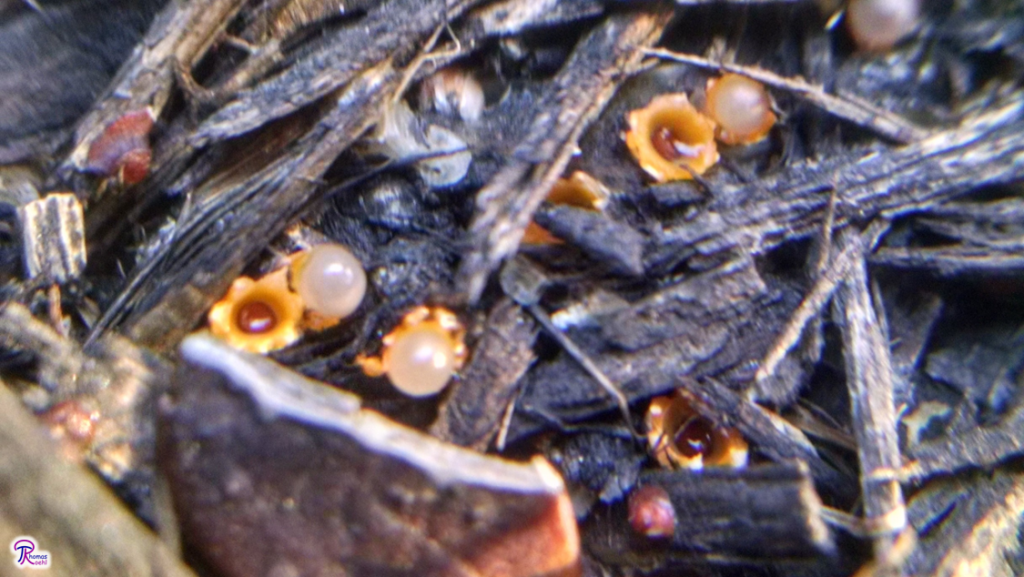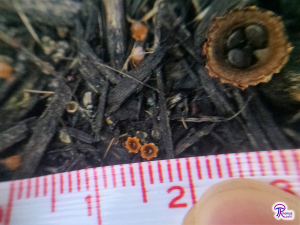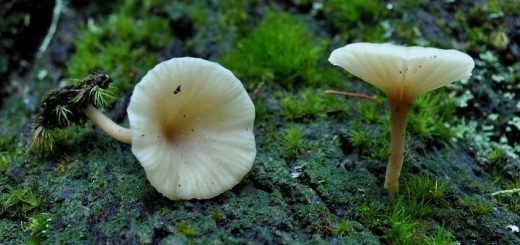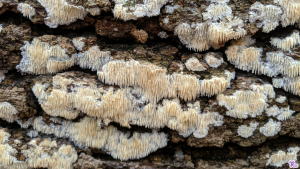#122: Sphaerobolus stellatus, the Artillery Fungus

Species in the genus Sphaerobolus discharge their spores by mechanically launching a large glob of them into the air. The leftmost mushroom in this picture is still developing and you can see the dark brown glob of spores in the center. Next to it is a mushroom that recently launched its spores, as evidenced by the white, popped-out membrane that is normally below the spore glob.
Sphaerobolus stellatus has one of the most unusual spore dispersal mechanisms: its base pops up and quickly flings a glob of spores into the air. The fungus forms tiny (no more than 3mm across) star-shaped mushrooms in mulch, which can cause problems for homeowners when the spore globs glue themselves to cars, siding, and the like. S. stellatus’s unique spore dispersal strategy has resulted in a variety of common names, including: “Artillery Fungus,” “Cannonball Fungus,” “Cannon Fungus,” “Sphere Thrower” (which is a literal translation of its Latin name), and “Shotgun Fungus.”1,2
Ecology
The most obvious trait these mushrooms have are the little black dots that pepper nearby surfaces. These dots are masses of spores launched by the fungus, which is usually hiding in a nearby mulch bed. S. stellatus grows on decaying wood and especially likes eating mulch. Although it appears in natural settings on downed logs and sticks (and the dung of some animals), it has adapted exceptionally well to urban and suburban areas thanks to mulch. S. stellatus appears in the summer and fall when there is plenty of moisture and light and the temperature is between 10°C and 20°C.3
This habitat often causes headaches for homeowners, who regularly find the discharged spore sacs stuck to cars, siding, windows, or any other surface near a garden. These dots are very difficult to remove once they dry and may stain the surface underneath them. The easiest solution is probably to repaint the affected surface.3
Getting rid of the Artillery Fungus itself is just as difficult. Like all other fungi, there is really no way to eliminate S. stellatus. The best course of action is to try different mulch. If you have been using hardwood mulch, try switching to conifer mulch. Additionally, you can try applying mulch that is 85% or more bark, since the fungus does not grow on bark as easily. These strategies may or may not work; fungi don’t like playing by our rules. The fungal spores can remain viable for over 10 years, so the fungus may reappear if you use a suitable bark in the future.2,3 In my yard, I found S. stellatus one year and it hasn’t returned since. I didn’t change anything, so I can’t provide any insights about why this might have happened.
Description and Life Cycle
S. stellatus grows up to 3mm (very tiny!) across and is yellow-orange to whitish in color. This makes it nearly impossible to spot when growing on wood. When I find these mushrooms, it’s usually because I’ve stopped to examine another small mushroom such as a bird’s nest mushroom. Newly-forming fruiting bodies are white spheres that are too small to measure with a normal ruler. As the spheres get older, the top of the mushroom splits into triangular rays (usually between four and nine), much like a minuscule earthstar (see FFF#044).1,4
The inner surface of the mushroom is orange to yellow and bowl-shaped with a darker, spherical mass sitting at the bottom of the bowl. This darker sphere is the structure that contains the spores and is called a “peridiole” or “gleba.” Thanks to the presence of this peridiole, field guides usually place S. stellatus with the bird’s nest fungi (see FFF#043). As the mushroom gets closer to releasing its spores, the peridiole grows to about 1.5mm in diameter and darkens to become reddish-brown to dark brown.1,4
When the mushroom is fully mature, it releases its spores by mechanically launching the peridiole into the air. The top layer of the inner surface of the Artillery Fungus suddenly pops out, much like a safety button on top of a sealed jar or the dice-rolling contraption at the center of a children’s board game (does anyone remember Pop-O-Matic Trouble?). This action is accompanied by a small popping sound reminiscent of the sound made by raindrops falling on leaves, Pop Rocks, or Rice Krispies.2 A good time-lapse video of the mushroom’s growth is available on Youtube.
Mycologists don’t know exactly how the popping action works. Presumably, the cells of the inner surface break down a lot of glycogen into sugars, which draws water into those cells. The result is that water pressure builds up in the cells, eventually forcing the inner surface pop out. This hypothesis has proven difficult to test, thanks in large part to the mushroom’s small size.5
Whatever the mechanism, it has some spectacular results. S. stellatus can throw its peridiole up to 14 feet (4.3 meters) high and 18 feet (5.5 meters) away. This would be equivalent to a six-foot-tall human throwing a baseball roughly 1.5 miles into the air and nearly 2 miles in distance.2 The mushroom can sense bright light and generally discharges its peridiole towards the nearest light source.3 This ability helps S. stellatus because it usually grows on sticks and other woody debris on the forest floor, which is often covered by dense foliage. Sensing light enables the mushroom to shoot its peridioles through gaps in the leaf cover, allowing its spores to travel farther.
The peridiole is encased in a sticky coating that effectively glues the spore sac to any surface upon which it lands. Each peridiole contains two different types of cells – spores and gemmae – so there are two ways that S. stellatus grows after it lands on a viable surface. The spores germinate only after passing through the digestive system of a herbivore. Peridioles are often seen stuck to leaves of grasses and short plants, where they are likely to be eaten. The animals benefit S. stellatus by distributing its spores over a wider area than the fungus can on its own. If the peridiole lands directly on wood, the large oval-ish cells called “gemmae” can germinate. Gemmae produce hyphae that can grow directly into a wood substrate. This provides an obvious benefit to the fungus: if the peridiole lands on wood, the fungus can begin growing immediately.2
Similar Species
There are actually three species of Sphaerobolus that occur in North America: S. stellatus, S. iowensis, and S. ingoldii. Only S. ingoldii can be differentiated from the others based on morphological analysis. This species forms peridioles that are 1mm in diameter, while the other two form peridioles roughly 1.5mm in diameter.1 All three of them can be differentiated after microscopic examination. S. iowensis has gemmae and Swiss cheese-like holes inside its peridioles called “basidial chambers.” S. stellatus also has gemmae, but lacks basidial chambers. S. ingoldii has neither gemmae nor basidial chambers.6

S. ingoldii is the only North American species of Sphaerobolus that is identifiable without a microscope; its peridioles are only 1mm wide, while the other two species have peridioles that are 1.5mm wide.
All three Sphaerobolus species are widely distributed in North America, but S. ingoldii seems to be less common than the other two (and, of course, it’s the only one that I’ve found – the pictures on this page are actually S. ingoldii). Preliminary research suggests that in North America, S. iowensis is at least as common as S. stellatus.6 S. stellatus is distributed all across the world,3 although I am unaware of any studies examining the genetics of the S. stellatus clade on a global level. This could mean that there are more species hiding under the name S. stellatus.
Taxonomy
Sphaerobolus belongs to the order Geastrales. This means that the Artillery Fungus is most closely related to the earthstars instead of the bird’s nest fungi. Within the Geastrales, mycologists place Sphaerobolus in the family Sphaerobolaceae.7 This family contains only one genus – Sphaerobolus.8 In other words, Sphaerobolus is only distantly related to the earthstars and has no close relatives.
The name “Sphaerobolus” translates to “sphere thrower” and “stellatus” translates to “star-shaped.”1 S. ingoldii was named after a prominent mycologist6 and S. iowensis is, I believe, named after the U.S. state of Iowa.
| Kingdom | Fungi |
| Division (Phylum) | Basidiomycota |
| Subdivision (Subphylum) | Agaricomycotina |
| Class | Agaricomycetes |
| Subclass | Phallomycetidae |
| Order | Geastrales |
| Family | Sphaerobolaceae |
| Genus | Sphaerobolus |
| Species | Sphaerobolus stellatus Tode7
Sphaerobolus ingoldii Geml, D.D. Davis & Geiser9 Sphaerobolus iowensis L. B. Walker10 |
See Further:
http://botit.botany.wisc.edu/toms_fungi/jul2005.html
http://www.mykoweb.com/CAF/species/Sphaerobolus_stellatus.html
http://www.ct.gov/caes/cwp/view.asp?a=2815&q=376840
https://extension.umaine.edu/ipm/ipddl/publications/5103e/
http://www.clemson.edu/extension/hgic/hot_topics/2010/03artillery_fungus.html
Citations
- Emberger, G. Sphaerobolus stellatus. Fungi Growing on Wood (2008). Available at: https://www.messiah.edu/Oakes/fungi_on_wood//bird’s%20nest%20fungi/species%20pages/Sphaerobolus%20stellatus.htm. (Accessed: 20th January 2018)
- Leonard, L. & Volk, T. J. Tom Volk’s Fungus of the Month for July 2005. Tom Volk’s Fungi (2005). Available at: http://botit.botany.wisc.edu/toms_fungi/jul2005.html. (Accessed: 20th January 2018)
- Douglas, S. M. Sphaerobolus stellatus–The Artillery Fungus. The Connecticut Agricultural Experiment Station (2007). Available at: http://www.ct.gov/caes/cwp/view.asp?a=2815&q=376840. (Accessed: 20th January 2018)
- Wood, M. & Stevens, F. California Fungi—Sphaerobolus stellatus. The Fungi of California Available at: http://www.mykoweb.com/CAF/species/Sphaerobolus_stellatus.html. (Accessed: 20th January 2018)
- Lepp, H. Birds Nest and Cannonball Fungi. (2011). Available at: https://www.anbg.gov.au/fungi/birds-nest-cannonball.html. (Accessed: 20th January 2018)
- Geml, J., Davis, D. D. & Geiser, D. M. Systematics of the genus Sphaerobolus based on molecular and morphological data, with the description of Sphaerobolus ingoldii sp. nov. Mycologia 97, 680–694 (2005).
- Sphaerobolus stellatus. Mycobank Available at: http://www.mycobank.org/Biolomics.aspx?Table=Mycobank&MycoBankNr_=196509. (Accessed: 20th January 2018)
- Sphaerobolaceae. Mycobank Available at: http://www.mycobank.org/BioloMICS.aspx?TableKey=14682616000000067&Rec=433258&Fields=All. (Accessed: 20th January 2018)
- Sphaerobolus ingoldii. Mycobank Available at: http://www.mycobank.org/BioloMICS.aspx?TableKey=14682616000000067&Rec=405478&Fields=All. (Accessed: 20th January 2018)
- Sphaerobolus iowensis. Mycobank Available at: http://www.mycobank.org/BioloMICS.aspx?TableKey=14682616000000067&Rec=25875&Fields=All. (Accessed: 20th January 2018)



![#146: Gliophorus psittacinus, the Parrot Mushroom [Archived]](https://www.fungusfactfriday.com/wp-content/themes/hueman/assets/front/img/thumb-medium-empty.png)





![#011: Characteristics of Kingdom Fungi [Archived]](https://www.fungusfactfriday.com/wp-content/themes/hueman/assets/front/img/thumb-small-empty.png)

